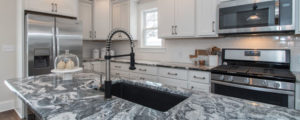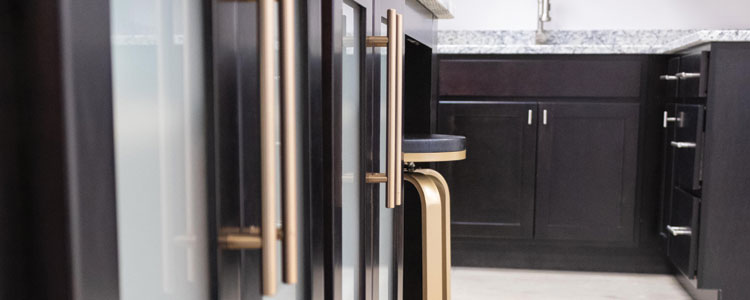Install Your Cabinet Hardware like a Pro
By Ryan Horvath
Installing cabinet hardware is one of the easiest DIY projects a homeowner can do. However, it’s also one that terrifies homeowners. I completely understand. You spent a lot of money on your new cabinets. The last thing you want to do is damage them. This week’s blog is going to teach you how to install your cabinet hardware like a pro. I’ll also share some tips I found during my research.
Install Your Hardware, Then Protect Your Investment
GETTING STARTED
You’ll need some tools to get started. The list is below:
- Ruler or measuring tape
- Cardboard (an old cereal box works) or store-bought template
- Awl or nail
- Drill
- Correct sized drill bit (check your hardware diagram for size)
- Scrap piece of wood
- Clamps
- Level
Using a template will make installing cabinet hardware easier and faster. It will also give your cabinetry a unified look and reduces mistakes. You can either make a template or buy one from your local hardware store. For me, I prefer the store-bought one. They’re made from either plastic or metal with multiple pre-drilled holes. They also help reduce user error. Tape over the unused holes to make certain that you’re using the same hole.
For the over-achieving DIYer, you can make a template using cardboard or an old cereal box. When you cut your cardboard, try to get it as square as possible. Measure 2 ½” to 3” in from one edge of the cardboard. Then measure half the width of the stile from the adjacent edge. Not sure of what a stile is? Check out our “Cabinets 101: Cabinet Vocabulary” blog. Finally, punch out the holes using an awl or nail.
INSTALLING DOOR HARDWARE
To install your door hardware, follow the directions below:
- Line your template up with your door.
- Make an indent for your holes using an awl or nail. Avoid using a pencil. The indent will act as a guide for your drill. It also won’t allow your drill to “skip” or move around. Also, be sure not to use the template to help you drill. Whether homemade or store-bought, your template’s hole can gradually start to widen. This will lead to mismeasurements.
- Clamp the scrap piece of wood to the inside of the door behind the indent. The scrap wood protects the finish on the inside of the door. It will also give you a clean, professional look.
- Keeping the drill level, drill into the door. Be sure to hold the door open while drilling. This will help protect from accidentally drilling into the face frame.
- Attach your hardware. I would recommend using a little bit of thread sealant on the screws. Thread sealant, like Loctite, ensures that the screw won’t become loose.
INSTALLING DRAWER HARDWARE
To install your knob hardware to your drawer, follow the directions below:
- To find your center, use a straight edge. Measure from the top corner to the adjacent bottom corner and mark with a pencil.
- Repeat on the other side. Use an awl or nail to make an indent at the center point.
- Clamp the scrap piece of wood to the inside of the drawer behind the indent.
- Keep the drill level and drill into the drawer.
- Attach your cabinet hardware.
To install your pull hardware, you can either use your store-bought template or make one. To make one, follow the directions below:
- For a slab drawer front, measure the drawer front. For a Shaker-style drawer front, measure the center panel. Cut a piece of cardboard to size.
- Fold the cardboard in half both long and short ways. At the center point, use a pencil to mark with a cross.
- Your cabinet hardware should come with a diagram. The diagram will state the distance between the holes. Divide the number by two and measure from the center point. Mark your holes with a pencil.
- Double-check the hole placements with your cabinet hardware. Then punch out the holes with an awl or nail.
- Place your template on the drawer and mark the holes with a pencil. Use a level to double-check the alignment. Once level, add indents for the holes using an awl or nail.
- Clamp the scrap piece of wood to the drawer behind the indents.
- Keep the drill level and drill into the drawer.
- Attach your cabinet hardware.
EXTRA TIPS I FOUND
While researching this week’s blog, I found some tips I thought were worth mentioning. One of the tips is using adhesive putty to help find your position. The store-bought templates have multiple pre-drilled holes to choose from. Using a pencil to mark a few spots, the putty gives you a chance to see how your hardware looks before you commit. Attach the putty to the hardware and test it out.
If you’re switching from pulls to knobs, use a backplate to cover old screw holes. If the backplate doesn’t cover the holes, use wood putty. Take the cabinet door to your local hardware store to match with wood putty. Using three colors of wood putty, match the dark, light, and mid-tone grains. Mix all three to create a near-flawless fix.
The last tip is to use superglue with your knobs. While thread sealant secures the screw, it doesn’t secure the knob. Over time, knobs will move around or shift. To be honest, I’m not the biggest fan of this tip. It’s a good idea if you’re not planning on changing out your hardware. However, tastes change. You will most likely damage your cabinets while replacing your hardware.
THE WRAP-UP
Hopefully, after reading this blog, you feel more comfortable installing cabinet hardware. Just remember, like any new thing, take your time. With some patience and remembering to measure twice, you’ll be a cabinet hardware install pro in no time.
If you would like to subscribe to the weekly Choice Cabinet blog, please click on the button below!









